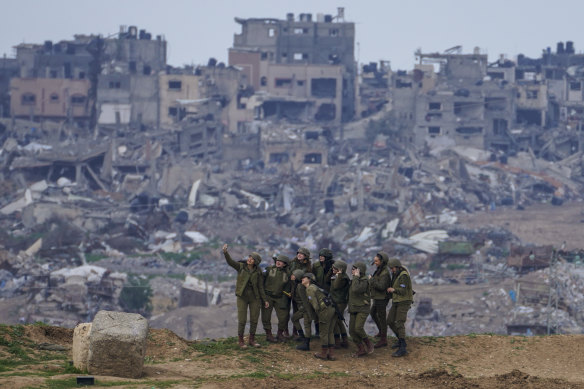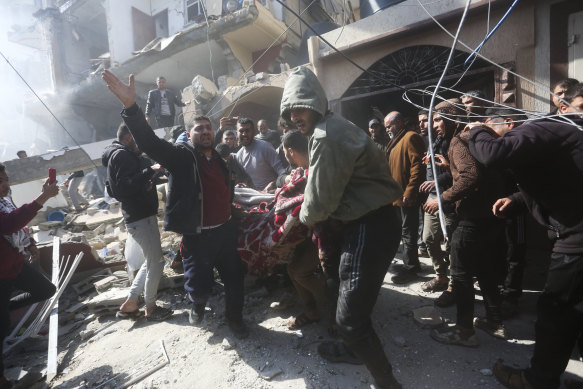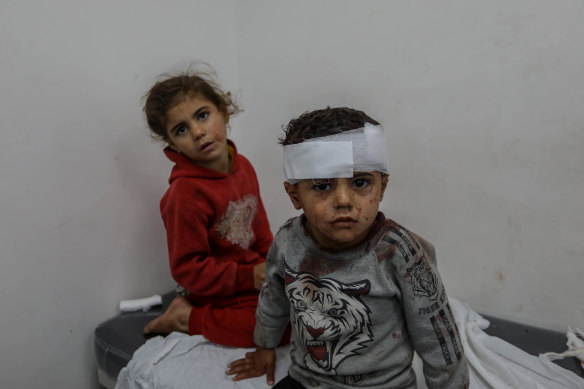
Israel for its part wants merely a pause in fighting to get hostages out of Gaza and more aid in, insisting that it will not end the conflict before Hamas is “eliminated”.
Israeli government spokesman Avi Hyman told a briefing before Hamdan spoke that the Islamist movement would have to “come down from their delusional positions and come into our orbit”.
He added: “Hamas understands military pressure and we are bringing it to them.”

Israeli female soldiers pose for a photo on a position on the Gaza Strip border, in southern Israel.Credit: AP Photo/Tsafrir Abayov
Biden said: “If we get to the circumstance that it continues to Ramadan ... it’s gonna be very dangerous.”
Palestinian-Israeli violence in Israel and the occupied Palestinian territories often spikes during Ramadan, as does hostility towards Israel in the Arab and Muslim world, creating a strong incentive for leaders to clinch a deal before then.
Hamas says Washington’s stance is designed to deflect blame from Israel if the talks collapse.
Senior Hamas official Bassem Naim said Hamas had presented its own draft deal, and was awaiting a response from Israel, adding: “[Prime Minister Benjamin] Netanyahu doesn’t want to reach an agreement and the ball now is in the Americans’ court”.

Palestinians rescue survivors after an Israeli strike in Rafah.Credit: AP
A source had told Reuters earlier that Israel was staying away because Hamas had refused to furnish a list of hostages who are still alive. Naim said this was impossible without a ceasefire as hostages were scattered across the war zone and held by separate groups.
The United States has also urged Israel to do more to alleviate the humanitarian catastrophe in Gaza, where more than 30,000 Palestinians have been killed by Israel’s assault, launched after Hamas attacks killed 1200 people in southern Israel in October.
Loading
“We must get more aid into Gaza,” Biden said.
US Secretary of State Antony Blinken said this also meant “making sure it can get to the people who need it ... the situation as it stands is simply unacceptable.”
Famine is now looming over the Gaza Strip as aid supplies, already sharply curtailed since the start of the war, have dwindled to barely a trickle over the past month. Swathes of the territory are completely cut off from food. Gaza’s few functioning hospitals, already overwhelmed by the wounded, are now filling with children starving to death.
Ahmed Cannan, a toddler with sunken eyes and an emaciated face, lay on a bed at Al-Awda clinic in Rafah, wrapped in a yellow cardigan. He had lost half his weight since the start of the war and now weighs just 6 kg.

Palestinian children receive treatment at Kuwait Hospital after Israeli airstrikes on Rafah, on February 12.Credit: Getty
“His situation worsens each day. God protect us from what is coming,” said his aunt, Israa Kalakh.
Nurse Diaa al-Shaer said such emaciated children were now arriving at the clinic in unprecedented numbers: “We will face a large number of patients who suffer from this, which is malnutrition.”
The situation is worse in the north of Gaza, beyond the reach of aid agencies or news cameras. Gaza health authorities say 15 children have now died of malnutrition or dehydration at one hospital.
The US military, in coordination with Jordan, airdropped 36,000 meals into northern Gaza on Tuesday, a program Washington began last week. Aid agencies say this is paltry compared to the scale of the hunger.
In a post on X, formerly Twitter, Biden said: “The United States is committed to pulling out every stop to get more aid to those in Gaza who desperately need it. We won’t stand by. We won’t let up.”
Israel says it is prepared to let in more aid through the two checkpoints on the southern edge of Gaza that it has permitted to open, and blames UN and other aid agencies for failing to distribute it more widely.
The agencies say this has become impossible with a breakdown of civil administration and law and order, and that it is up to Israel, whose troops have stormed Gaza’s towns and patrol them, to provide access and security for food distribution.
“The sense of helplessness and despair among parents and doctors in realising that lifesaving aid, just a few kilometres away, is being kept out of reach must be unbearable,” said Adele Khodr, UNICEF regional director for the Middle East and North Africa.
Reuters
Get a note directly from our foreign correspondents on what’s making headlines around the world. Sign up for the weekly What in the World newsletter here.









 Add Category
Add Category